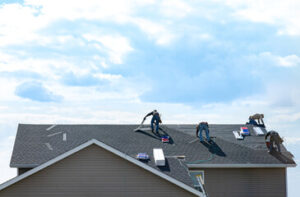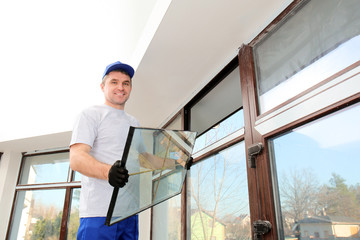Helena Roofers repair and install roofing systems. They can also inspect a roof and recommend any necessary repairs. They may work on residential or commercial properties.

Having your roof inspected regularly can help prevent serious damage from occurring in the future. Roofers can identify areas of wear and tear, leaks, or missing shingles. They can also install insulation to improve energy efficiency.
Roofers often work on residential homes, but they can also find jobs at commercial or industrial facilities. Regardless of where they work, roofers must be able to follow strict safety protocols and adhere to any additional regulations that may apply to their specific environment.
Roofing is a physically demanding job that requires constant movement and use of large or heavy materials. The work is typically done in warm weather, and roofers are required to wear appropriate clothing and footwear to protect themselves from the elements. This can include rubber gloves, hats, and sturdy boots, as well as a protective harness or helmet. Depending on the type of roof being worked on, roofers may need to use tools such as roofing shovels, pry bars, hammers, nail guns, power drills, and tape measures.
While most roofers are self-employed, some work for larger construction companies or in teams. They can often be expected to work overtime during the summer season in order to meet deadlines. During the offseason, they may be expected to stay on staff to complete training or other educational requirements.
The average salary for a roofer is $61,000 per year, but this can vary significantly based on location and other factors. For example, the average salary in New York is higher than the average salary in Utah. The Zippia Research Team spent countless hours reviewing resumes, job postings, government data, and other sources in order to compile this information. The team was comprised of professional writers and data scientists.
Job Duties
Roofers install, repair and replace roofs on houses or commercial buildings. They may use a variety of roofing materials, including asphalt shingles, metal and bitumen. The job description includes inspecting the structure to determine the best course of action, laying underlayment and then applying shingles or other material. Other duties include removing old material and cleaning up the work site. They often work on ladders or scaffolding, and are exposed to the elements for long periods of time.
To be a successful roofer, you need to have excellent physical fitness. The job requires a lot of lifting, standing and hammering, and it can be very physically demanding, especially in hot weather. The responsibilities also involve working with power tools and climbing up or down ladders or scaffolding.
Some roofers specialize in specific types of roofs. Shinglers, for example, lay asphalt shingles; single-ply roofers focus on flat or low-sloped roofs; and metal roofers install sheet goods or membrane roofs. Others focus on green technology rooftop applications, such as vegetative roofs and rainwater harvesting systems, while others install solar shingles or panels.
Before starting a project, roofers must prepare the work area by setting up scaffolding and ladders safely. They also make sure to account for all materials needed to complete the job. During the work, roofers must constantly be aware of their surroundings and keep in mind safety regulations.
Upon completion of the roof, roofers clean the work area and remove all debris. They also inspect the finished roof for leaks and other problems. If there are any issues, they must fix them as quickly and effectively as possible.
Roofers must be comfortable with a wide range of tools, including hand tools such as shovels and shingle cutters, and power tools such as hammers, saws and nail guns. They must be able to read and follow instructions and blueprints. They must be proficient in identifying and estimating the amount of materials needed to complete a task, and they should have good problem-solving skills. In addition, roofers must be able to work well under pressure and meet strict deadlines.
Training Requirements
To begin a career as a roofer, one must have a high school diploma or equivalent. Some roofing apprenticeship programs combine on-the-job training with classroom instruction. A roofer should also have basic math skills and an understanding of safety protocols. Physical strength and stamina are important for working at heights, lifting materials and moving around a construction site. A strong attention to detail is essential to ensure that roofing materials are installed properly and that no leaks occur in the finished product.
The National Roofing Contractors Association offers a wide variety of roofing courses for both new and experienced roofers. These courses can teach workers how to install different types of roofing systems and how to perform repair work. These classes can help students to become certified as roofers, which may give them a leg up in the job market.
In New Mexico, roofing contractors must have a state license in order to do business. This requires passing a trade exam and a business law exam. There are also local licensing requirements that must be met. The license must be renewed periodically.
A roofer must be able to read blueprints and understand construction methods and materials. In addition, he or she must be able to respond to service calls and solve problems on the fly. Roofers must also have good communication skills, as they often interact with clients. They must be able to explain the process of installing and repairing a roof, as well as answer any questions that the client might have.
Depending on the type of roofing material used, a roofer must have specific skills. For example, a roofing contractor who works with asphalt shingles must know how to install those materials correctly. He or she should also be familiar with the different types of roofing materials available, including flat roofing systems, tile roofing systems and metal roofing systems.
All roofers must have proper safety equipment. This includes hard hats, eye protection and boots that provide adequate traction on the ground or in a ladder. They should also be trained in the use of hand tools and power equipment, such as roofing torches. They should receive comprehensive training on occupational safety standards set by the Occupational Safety and Health Administration, and regularly attend refresher courses.
Working Conditions
Roofers often work in challenging working conditions. They may have to wake up early to get to the job site and might be required to take breaks during the hottest parts of the day to avoid heat stress. The job is also strenuous and requires heavy lifting. Accidents can happen at the job site when roofers are handling heavy materials or using power tools incorrectly.
A serious fall from a ladder or scaffolding can lead to fractured bones, back injuries, and even death. Workers can be electrocuted when they come into contact with overhead power lines or electrical equipment that is not properly grounded or fused. Exposure to extreme temperatures can cause heat-related illnesses like heat exhaustion or frostbite. Hazardous materials like asbestos or lead paint may pose respiratory issues for workers.
Worker’s compensation is the primary way that a roofing worker can receive medical attention and financial assistance if they become sick or injured on the job. While safety training and strict adherence to protocols can mitigate the risk of workplace injuries, these incidents still occur frequently.
As a result, many roofers want to purchase worker’s comp insurance for themselves and their employees. This coverage helps cover the cost of medical treatment and a portion of any lost wages, regardless of who is at fault for the injury or illness. It is typically offered through an insurance agency and can be obtained by both employers and independent contractors. It’s not unusual for a roofing contractor to have employees, but they might prefer to buy the policy independently to keep the premium costs low. This option is especially helpful for small businesses with limited resources.
